Wildlife of Sri Lanka
| Part of a series on |
| Wildlife of Sri Lanka |
|---|
|
Protected areas |
|
Flora and Fauna Birds of Sri Lanka (Endemics) Mammals of Sri Lanka (Endemics) |
|
Gardens Zoological gardens Pinnawela Elephant Orphanage Dehiwala Zoo Pinnawala Open Zoo Botanical gardens Hakgala Botanical Garden Henarathgoda Botanical Garden Mirijjawila Botanical Garden Peradeniya Botanic Gardens Seetawaka Botanical Garden |
|
Organizations Authorities Department of Forest Conservation Department of Wildlife Conservation Civil societies Field Ornithology Group |
|
Related topics |
Wildlife of Sri Lanka includes its flora and fauna and their natural habitats. Sri Lanka has one of the highest rates of biological endemism (16% of the fauna and 23% of flowering plants are endemic[1]) in the world even though it is relatively small.
Ecological zones
The mountains and the southwestern part of the country, known as the "wet zone," receive ample rainfall (an annual average of 2500 millimeters). Most of the southeast, east, and northern parts of the country comprise the "dry zone, which receives between 1200 and 1900 mm of rain annually.
Fauna

Mammals
Sri Lanka is home to roughly 123 species of mammals, 41 of which are threatened (9 critically). 16 of the species are endemic, of which 14 are threatened,[2] including the large sloth bear, the endemic Sri Lanka leopard and Sri Lankan elephant and the sambar. Bats have the highest amount of species (out of 200 mammalian orders), with 30 different species. Sri Lanka's surrounding waters are home to 28 species of Cetaceans.
Reptiles
Sri Lanka currently contains 173 species of reptiles, of which 56 are threatened and 103 are endemic. Most of the reptiles are snakes and the largest are two species of crocodile, the mugger crocodile and saltwater crocodile.[2]
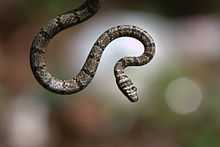
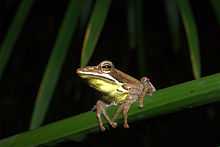
Amphibians
Sri Lanka has one of the richest diversity of amphibians in the world, containing over 119 species of amphibians up to 2015, with 109 endemic species.[2] and has been claimed to have the highest amphibian species density in the world[3] though that has been challenged.[4] 52 species of amphibians in Sri Lanka are threatened, all but one of which are endemic.
Birds
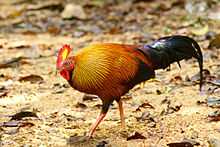
Sri Lanka is home to 227 species of birds (though some past estimates put it as high as 486[5]), 46 of which are threatened (10 critically).[2]
Fish
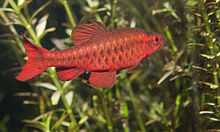
Sri Lanka contains 93 species of freshwater fish, and 50 of which are endemic to the country. 28 species are categorized as threatened by IUCN.[2] There are 8 species of brackish water fish that also come to freshwater, and 24 introduced exotic fish species.
Lepidopterans
Butterflies
245 butterflies species are recorded from Sri Lanka of which 24 are endemic to the island
Moths
Insects
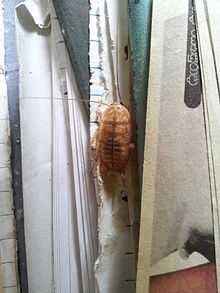
Insects belonging to all 32 orders except Grylloblattodea have been recorded from the Sri Lanka.The total number of insect species recorded from the island is about 11,144. Coleoptera number 3033 species , Lepidoptera 2158 species, and Hymenoptera 1519 species. [6]
Bees
There are about 70,000 bee species of bees described in the world with nearly 450 genera and 7 families. Out of them, Sri Lanka comprises 148 species included to 38 genera and 4 families.
Odonates
Damselflies categorized in to Suborder: Zygoptera; and dragonflies into Suborder: Anisoptera. There are 121 described species within 13 families can be found in Sri Lanka. 59 species from them are endemic.
Aphids
Sri Lanka comprises 74 species in 46 genera and 6 families. 2 endemic aphid species found on Sri Lanka.
Ants
Sri Lanka is home to 181 species of ants that included to 61 genera and 10 subfamilies. One endemic genus Aneuretus is also included to the list.
Freshwater crabs
All recorded 51 species along with 5 genera are totally endemic to Sri Lanka. 98% of those crabs are IUCN categorized as threatened, endangered or critically endangered animals.
Molluscs
There is known over 246 land gastropods of Sri Lanka.[7][8] Fauna of Sri Lanka also include freshwater snails. The number of marine molluscs of Sri Lanka is not known and there is about 240 species listed meantime in 2006.[9]
Arachnids
Tarantulas
There are 7 species of tarantulas are recorded from Sri Lanka. When considering with Indian subcontinent, 16 species of Poecilotheria are recorded from both countries; nine from India and seven from Sri Lanka.
Scorpions
There are 18 species of scorpions which are found in Sri Lanka. Out of these 18 species, 7 species are endemic to Sri Lanka. In addition to the endemic species, 4 subspecies of the 9 non-endemic species are also endemic to Sri Lanka.
Sri Lankan scorpions are included in 3 families.
- Family Buthidae
- Family Chaerilidae
- Family Scorpionidae
Flora
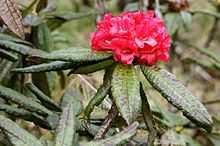
Diversity and endemism of plants in Sri Lanka are quite high.[10] There are 3,210 flowering plants belonging to 1,052 genera. 916 species and 18 genera are endemic to the island. Additionally, all but one of the island’s more than 55 dipterocarps are confined to Sri Lanka. Although not lately assessed, Sri Lanka’s ferns are estimated at about 350 species. Diversity, richness, and endemism across all taxa groups are much higher in the wet zone than in the dry zone. Wet zone, which accounts for only a quarter of Sri Lanka’s land area, harbours 88 percent of the flowering plants, and 95 percent of country's flowering plant endemics. The natural forests of Sri Lanka are categorized into eight types.[11]
See also
References
- ↑ "Biological diversity of Sri Lanka". Young Biologist Association, Sri Lanka. Retrieved 2009-09-12.
- ↑ 2.0 2.1 2.2 2.3 2.4 The Red List of Threatened Fauan and Flora of Sri Lanka. Colombo, Sri Lanka: The World Conservation Union (IUCN). 2007. p. 166. ISBN 978-955 -8177 -63-1. Retrieved 12-09-2009. Check date values in:
|accessdate=(help) - ↑ Pethiyagoda, Rohan; Kelum Manamendra-Arachchi (November 1998). "Evaluating Sri Lanka’s amphibian diversity". Occasional papers of Wildlife Heritage Trust of Sri Lanka 2. Retrieved 12-09-09. Check date values in:
|accessdate=(help) - ↑ Chaitra,, M. S.; Karthikeyan Vasudevan and Kartik Shanker (10-04-04). "The biodiversity bandwagon: the splitters have it". Current Science 86 (7): 3. Retrieved 12-09-09. Check date values in:
|date=, |accessdate=(help) - ↑ Kotagama, Sarath W.; Rex I. De Silva; Athula S. Wijayasinha; Vathsala Abeygunawardane (2006). "Avifaunal List of Sri Lanka". Colombo, Sri Lanka: IUCN. ISBN 978-955-8177-51-8.
- ↑ Anura Wijesekara1 et D. P. Wijesinghe, « History of insect collection and a review of insect diversity in Sri Lanka », Cey. J. Sci. (Bio.Sci.), vol. 31, 2003, p. 43-59 pdf
- ↑ Naggs F., Raheem D. C., Mordan P. B., Grimm B., Ranawana K. B. & Kumburegama N. P. S. (2003). "Ancient relicts and contemporary exotics: faunal change and survivorship in Sri Lanka’s snail fauna". Slugs & Snails: Agricultural, Veterinary & Environmental Perspectives, British Crop Protection Council Symposium Proceedings No. 80, 103 - 108.
- ↑ Ranawana K. B. (2006) "Land Snails in Sri Lanka". In: Bambaradeniya C. N. B. The Fauna of Sri Lanka: Status of Taxonomy, Research and Conservation. The World Conservation Union, Colombo, Sri Lanka & Government of Sri Lanka. 84-99. ISBN 955-8177-51-2.
- ↑ de Silva D. (2006) "Current Status of Taxonomy and Ecology of Marine Molluscs in Sri Lanka". In: Bambaradeniya C. N. B. The Fauna of Sri Lanka: Status of Taxonomy, Research and Conservation. The World Conservation Union, Colombo, Sri Lanka & Government of Sri Lanka. 84-99. ISBN 955-8177-51-2.
- ↑ "Unique and threatened biodiversity". biodiversityhotspots.org. Conservation International. Retrieved 2009-09-15.
- ↑ "Forest Resources". Forest resources of Sri Lanka Country report. Food and Agriculture Organization. Rome, 2001. Retrieved 2009-09-15. Check date values in:
|date=(help)
Bibliography
- Channa N. B. Bambaradeniya, ed. (2006). Fauna of Sri Lanka: Status of Taxonomy, Research and Conservation. Colombo, Sri Lanka: The World Convservation Union (IUCN). p. 308. ISBN 955-8177-51-2.
- Herat, T. R. Somaratna, S & Pradeepa, 1998, Common Vegetables of Sri Lanka. NARESA, Sri Lanka.
- Herat, T. R. 2005. Tentative Keys to the Families & Genera of Pteridophytes of Sri Lanka. Author Publisher.
- Herat, T. R. P. Ratnayake. 2005 An Illustrated Guide to the Fern Flora of Knuckles Conservation Area Sri Lanka. Author Publisher.
- Herat, T. R. 2005. Endemic Flowering Plants, Part I A Checklist & an Index to A Revised Handbook to the Flora of Ceylon. Author Publisher.
- Herat, T. R. 2007. Endemic Flowering Plants of Sri Lanka Part II A, Index to the Distribution of Plants with Localities. Environmental Ministry Colombo.
- Herat, T. R. 2007 Endemic Flowering Plants of Sri Lanka Part II B, Index to the Distribution within Agro Ecological Zones. Environmental Ministry Colombo.
- Herat, T. R. A. U. Herat, 2008. Index to the Distribution of Ferns & Fern-Allies within the Administrative Districts of Sri Lanka. Author Publisher.
- Herat, T. R. 2009. YS%, dxlSh imqIaml Ydl i|yd jQ isxy, fmdoq kdu iQpsh’ Author Publisher.
External links
| ||||||||||||||